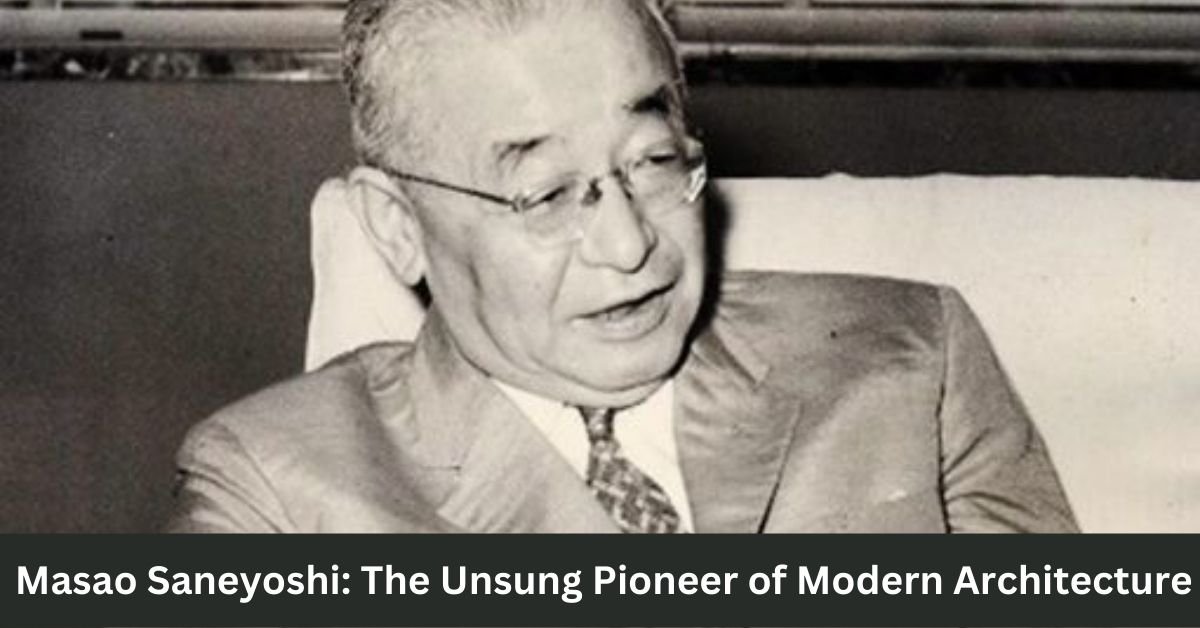Introduction
In the annals of modern architecture, names like Frank Lloyd Wright, Le Corbusier, and Ludwig Mies van der Rohe often dominate the discourse. However, there are many lesser-known architects whose contributions have been pivotal in shaping the architectural landscape of the 20th and 21st centuries. Among these is Masao Saneyoshi, a figure whose work remains underappreciated outside of specialised circles. Saneyoshi’s designs, philosophies, and influence on modern architecture deserve recognition. This article delves into his life, works, and legacy, revealing how his vision contributed to the evolution of contemporary architecture.
Early Life and Education
Masao Saneyoshi was born in 1931 in Kyoto, Japan, during a period of profound social and cultural change. The early 20th century was a time when Japan was transitioning from a feudal society into a modern nation-state, embracing industrialization and Western influences. This environment of flux played a significant role in shaping Saneyoshi’s outlook on architecture and design.
Saneyoshi’s interest in architecture was sparked at a young age, influenced by the traditional Japanese buildings in his hometown and the modernist structures he encountered in architecture magazines. His fascination with both the past and the future led him to pursue architecture at the University of Tokyo, where he studied under prominent architects who were instrumental in introducing modernist ideas to Japan.
During his time at the university, Saneyoshi was exposed to the works of international architects such as Le Corbusier and Walter Gropius. However, he was equally inspired by Japan’s traditional architecture, particularly the minimalist aesthetic and the harmonious relationship between buildings and nature. This dual influence would become a hallmark of his later work.
The Post-War Context and Early Career
The aftermath of World War II presented both challenges and opportunities for Japanese architects. The country was in ruins, and there was an urgent need for reconstruction. However, this also allowed for a rethinking of architectural practices and the integration of modernist principles into the rebuilding process.
Saneyoshi began his career in this context, joining a leading architectural firm in Tokyo. His early projects were largely focused on residential buildings, where he began to experiment with blending traditional Japanese elements with modernist design principles. This approach set him apart from his contemporaries, many of whom were fully embracing Western modernism without considering Japan’s architectural heritage.
One of Saneyoshi’s early notable works was a residential project in Tokyo, completed in 1958. The house, designed for a prominent businessman, was a modern interpretation of a traditional Japanese home. It featured sliding shoji screens, tatami mats, and a garden integrated into the design. However, it also incorporated modern materials like steel and glass, creating a seamless blend of the old and new. This project earned Saneyoshi critical acclaim and established him as a rising star in Japanese architecture.
The Philosophy of “Neo-Japanese Modernism”
As his career progressed, Saneyoshi began to articulate a philosophy that he termed “Neo-Japanese Modernism.” This approach was rooted in the belief that modern architecture in Japan should not merely imitate Western styles but should evolve from the country’s unique cultural and architectural traditions.
Neo-Japanese Modernism emphasised simplicity, natural materials, and the integration of buildings with their natural surroundings. Saneyoshi believed that architecture should be a reflection of both the past and the future, creating spaces that are both functional and spiritually enriching.
One of the key aspects of this philosophy was the use of natural materials such as wood, stone, and paper, which have been integral to Japanese architecture for centuries. Saneyoshi argued that these materials, when used in modern contexts, could create a sense of continuity with the past while also being environmentally sustainable.
Another important element of Neo-Japanese Modernism was the idea of “ma,” a concept in Japanese aesthetics that refers to the space between objects or the void. In architecture, “ma” can be seen in the careful consideration of the spaces between buildings, rooms, or even furniture. Saneyoshi applied this concept in his designs, creating spaces that felt open, balanced, and harmonious.
Major Works and Contributions
Masao Saneyoshi’s body of work includes a diverse range of projects, from residential buildings to public spaces, each reflecting his commitment to Neo-Japanese Modernism. Some of his most significant works include:
The Kyoto International Conference Center (1972)
One of Saneyoshi’s most celebrated projects, the Kyoto International Conference Center is a prime example of his philosophy in action. The building is set within a lush, natural landscape, and its design draws heavily on traditional Japanese architectural forms. The use of concrete, glass, and wood creates a modern structure that still feels deeply connected to its surroundings. The interior spaces are designed to facilitate communication and collaboration, with an emphasis on openness and light.
The Tokyo Residential Complex (1980)
This residential project in Tokyo is another example of Saneyoshi’s innovative approach. The complex was designed to provide affordable housing in a densely populated urban area while maintaining a high standard of living. The design incorporates communal gardens, shared spaces, and a layout that maximises natural light and ventilation. The use of traditional Japanese elements, such as wooden screens and courtyards, adds a sense of tranquillity to the urban environment.
The Nagoya Cultural Center (1985)
The Nagoya Cultural Center is a cultural and community hub that reflects Saneyoshi’s belief in the social role of architecture. The building’s design encourages interaction and engagement, with open spaces that invite people to gather and participate in cultural activities. The centre’s architecture blends modern and traditional elements, with a focus on natural materials and a connection to the surrounding environment.
The Osaka Pavilion at the 1990 World’s Fair:
Saneyoshi was chosen to design Japan’s pavilion for the 1990 World’s Fair in Osaka. The pavilion was a showcase of Neo-Japanese Modernism, featuring a structure that combined traditional Japanese craftsmanship with cutting-edge technology. The design highlighted the importance of sustainability and the harmonious relationship between humans and nature, themes that were central to Saneyoshi’s work.
Influence on Contemporary Architecture
While Masao Saneyoshi may not be a household name, his influence on contemporary architecture is undeniable. His ideas and designs have inspired a generation of architects, both in Japan and internationally, who seek to create buildings that are both modern and rooted in tradition.
One of the ways Saneyoshi’s influence can be seen is in the growing interest in sustainable architecture. His emphasis on natural materials and the integration of buildings with their environments anticipated many of the principles of sustainable design that are now widely accepted. Architects today continue to explore the possibilities of using traditional materials in modern contexts, a practice that Saneyoshi championed decades ago.
Saneyoshi’s work also contributed to the global appreciation of Japanese architecture. While Japan has long been recognized for its traditional buildings, Saneyoshi helped to demonstrate that modern Japanese architecture could be innovative, forward-looking, and deeply connected to cultural heritage. This has led to a broader recognition of Japan’s contributions to modern architecture and an increased interest in Japanese design principles worldwide.
Challenges and Criticisms
Despite his many accomplishments, Saneyoshi’s career was not without its challenges and criticisms. Some critics argued that his adherence to traditional Japanese elements limited his work’s appeal in an increasingly globalized world. They contended that his designs, while beautiful and culturally significant, were too rooted in Japan’s past and did not fully embrace the possibilities of modern architecture.
Others criticized Saneyoshi for his reluctance to adopt certain technological innovations, particularly in the later years of his career. As architecture became more technologically driven, some saw Saneyoshi’s focus on natural materials and traditional methods as outdated.
However, Saneyoshi defended his approach, arguing that architecture should not be about following trends but about creating spaces that are meaningful, sustainable, and in harmony with their surroundings. He believed that the true measure of architecture was not in its novelty but in its ability to enhance the lives of those who inhabit it.
Legacy and Recognition
Masao Saneyoshi passed away in 2007, leaving behind a legacy that continues to resonate in the world of architecture. Although he did not achieve the same level of fame as some of his contemporaries, his contributions to the field are increasingly recognized and celebrated.
In recent years, there has been a resurgence of interest in Saneyoshi’s work, particularly among younger architects who are drawn to his philosophy of Neo-Japanese Modernism. His buildings are studied in architecture schools around the world, and his ideas continue to influence contemporary architectural practice.
In Japan, several of Saneyoshi’s buildings have been designated as cultural landmarks, ensuring that his work will be preserved for future generations. Retrospective exhibitions of his work have been held in major cities, and publications dedicated to his life and career have helped to bring his contributions to a wider audience.
Conclusion
Masao Saneyoshi was a visionary architect who sought to bridge the gap between tradition and modernity. His philosophy of Neo-Japanese Modernism offered a unique approach to architecture that was both innovative and deeply rooted in cultural heritage. While his work may not have received the widespread recognition it deserves during his lifetime, his influence on contemporary architecture is undeniable.
Saneyoshi’s legacy lies in his ability to create buildings that are not only aesthetically pleasing but also meaningful, sustainable, and in harmony with their surroundings. As the world continues to grapple with the challenges of urbanization, climate change, and cultural preservation, Saneyoshi’s ideas offer valuable insights into how architecture can respond to these issues in a thoughtful and impactful way.
Read More: How Amber Najm Parents Shaped Her Values and Success





